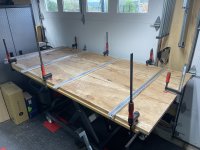DavidCBaker
Member
- Joined
- May 31, 2010
- Messages
- 535
Folks, I could use your help. My son had a massive 160' tree come down. He hired a portable sawmill guy to come and slab it, and we're using that to build a dining room table for their new home. Between you and me, pecan is a total PITA to work with. The only reason I'm doing it is for memory purposes and to make him happy.
We're all done except sanding, some edging treatment, and attaching the legs. I have two questions:
First, can I just use some high grade lag bolts (4 per leg) to attach them? Should I put a larger flat piece between the legs and the slab? Should I use threaded inserts (I've never used them)? The table is large (4 x 8') and heavy, heavy.
Second, it seems to naturally warp. The wood moisture level is good and it's been drying for two years, so I don't think we didn't wait long enough. The wood has incredible embedded forces. As you can see, I've kept it straight by clamping it to my Felder Assembly Table. The attached legs will strengthen it a bit, but I'm wondering if I should mount two or three extruded aluminum pieces underneath? (I've laid a few on it to show you what I mean.)
Thanks, folks.
We're all done except sanding, some edging treatment, and attaching the legs. I have two questions:
First, can I just use some high grade lag bolts (4 per leg) to attach them? Should I put a larger flat piece between the legs and the slab? Should I use threaded inserts (I've never used them)? The table is large (4 x 8') and heavy, heavy.
Second, it seems to naturally warp. The wood moisture level is good and it's been drying for two years, so I don't think we didn't wait long enough. The wood has incredible embedded forces. As you can see, I've kept it straight by clamping it to my Felder Assembly Table. The attached legs will strengthen it a bit, but I'm wondering if I should mount two or three extruded aluminum pieces underneath? (I've laid a few on it to show you what I mean.)
Thanks, folks.


